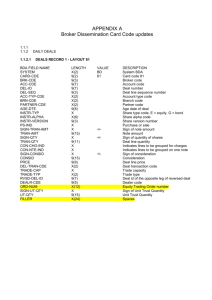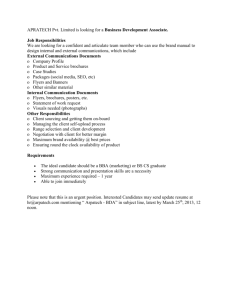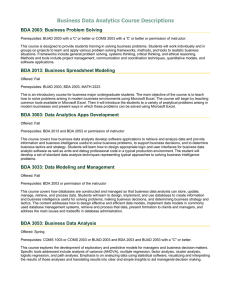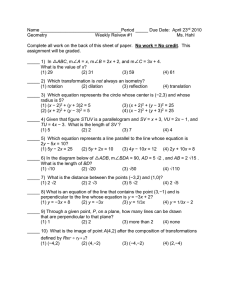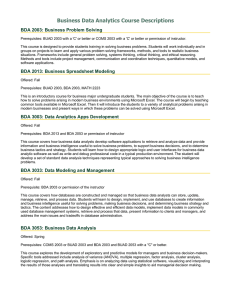Installing Bi-Directional-Amplifiers
advertisement
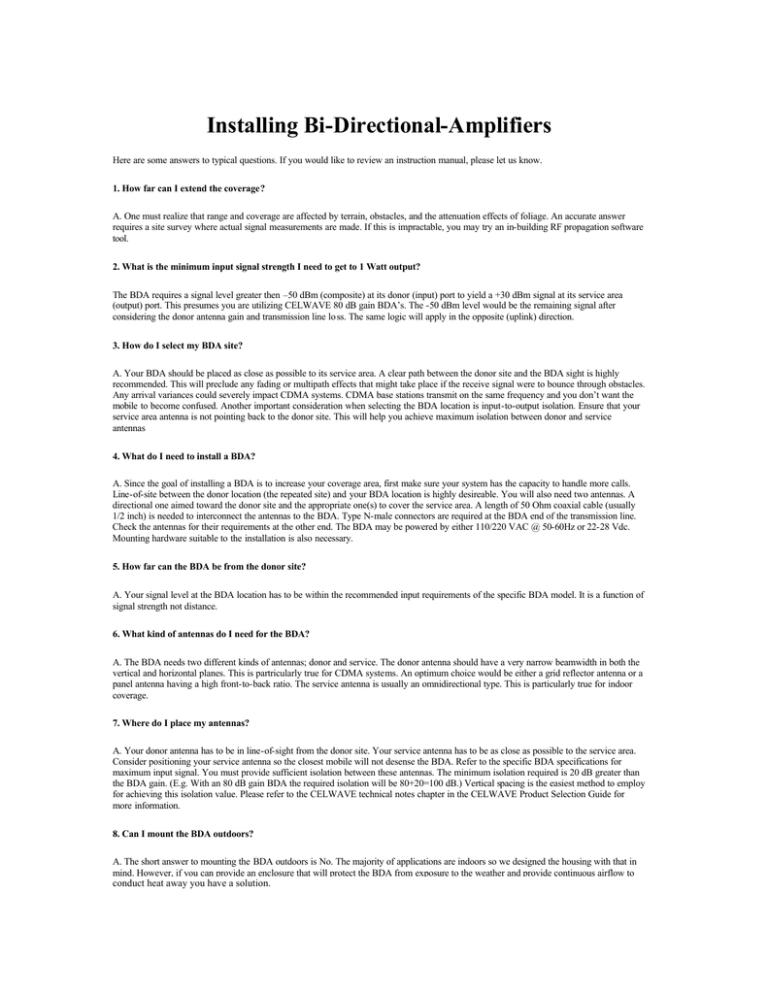
Installing Bi-Directional-Amplifiers
Here are some answers to typical questions. If you would like to review an instruction manual, please let us know.
1. How far can I extend the coverage?
A. One must realize that range and coverage are affected by terrain, obstacles, and the attenuation effects of foliage. An accurate answer
requires a site survey where actual signal measurements are made. If this is impractable, you may try an in-building RF propagation software
tool.
2. What is the minimum input signal strength I need to get to 1 Watt output?
The BDA requires a signal level greater then –50 dBm (composite) at its donor (input) port to yield a +30 dBm signal at its service area
(output) port. This presumes you are utilizing CELWAVE 80 dB gain BDA’s. The -50 dBm level would be the remaining signal after
considering the donor antenna gain and transmission line lo ss. The same logic will apply in the opposite (uplink) direction.
3. How do I select my BDA site?
A. Your BDA should be placed as close as possible to its service area. A clear path between the donor site and the BDA sight is highly
recommended. This will preclude any fading or multipath effects that might take place if the receive signal were to bounce through obstacles.
Any arrival variances could severely impact CDMA systems. CDMA base stations transmit on the same frequency and you don’t want the
mobile to become confused. Another important consideration when selecting the BDA location is input-to-output isolation. Ensure that your
service area antenna is not pointing back to the donor site. This will help you achieve maximum isolation between donor and service
antennas
4. What do I need to install a BDA?
A. Since the goal of installing a BDA is to increase your coverage area, first make sure your system has the capacity to handle more calls.
Line-of-site between the donor location (the repeated site) and your BDA location is highly desireable. You will also need two antennas. A
directional one aimed toward the donor site and the appropriate one(s) to cover the service area. A length of 50 Ohm coaxial cable (usually
1/2 inch) is needed to interconnect the antennas to the BDA. Type N-male connectors are required at the BDA end of the transmission line.
Check the antennas for their requirements at the other end. The BDA may be powered by either 110/220 VAC @ 50-60Hz or 22-28 Vdc.
Mounting hardware suitable to the installation is also necessary.
5. How far can the BDA be from the donor site?
A. Your signal level at the BDA location has to be within the recommended input requirements of the specific BDA model. It is a function of
signal strength not distance.
6. What kind of antennas do I need for the BDA?
A. The BDA needs two different kinds of antennas; donor and service. The donor antenna should have a very narrow beamwidth in both the
vertical and horizontal planes. This is partricularly true for CDMA systems. An optimum choice would be either a grid reflector antenna or a
panel antenna having a high front-to-back ratio. The service antenna is usually an omnidirectional type. This is particularly true for indoor
coverage.
7. Where do I place my antennas?
A. Your donor antenna has to be in line-of-sight from the donor site. Your service antenna has to be as close as possible to the service area.
Consider positioning your service antenna so the closest mobile will not desense the BDA. Refer to the specific BDA specifications for
maximum input signal. You must provide sufficient isolation between these antennas. The minimum isolation required is 20 dB greater than
the BDA gain. (E.g. With an 80 dB gain BDA the required isolation will be 80+20=100 dB.) Vertical spacing is the easiest method to employ
for achieving this isolation value. Please refer to the CELWAVE technical notes chapter in the CELWAVE Product Selection Guide for
more information.
8. Can I mount the BDA outdoors?
A. The short answer to mounting the BDA outdoors is No. The majority of applications are indoors so we designed the housing with that in
mind. However, if you can provide an enclosure that will protect the BDA from exposure to the weather and provide continuous airflow to
conduct heat away you have a solution.
9. Is there a special FCC approval required for outdoor mounting?
A. No, there is no special FCC approval for using the BDA in outdoor applications given that:
·
·
·
·
You are expanding the coverage in an area that you are licensed to radiate this specific frequency or range of frequencies;
You are using class A amplifiers equipped with AGC limited to 5 Watts ERP, (class B is limited to 5Watts ERP for each
authorized frequency);
You meet emissions limits of 90.209;
Class B is permitted only in confined or indoor areas.
The above restrictions meet FCC 90.209 requirements.
10. I want to eliminate some undesired frequencies passing through the BDA.
Can I narrow the pass band?
A. CELWAVE realizes that the world out there is not perfect. Filters are the easiest and most economical way to achieve the type of
coverage you are looking for. CELWAVE BDA's include connections for external filters. We have provided sufficient amplifier gain to
overcome typical insertion loss. The external filter ports are SMA female type. You can interrupt either the forward (downlink) path, the
reverse (uplink) path, or both with a more selective device. You may install a filter to pass a particular block of frequencies or reject
unwanted frequencies. You can use one of our pass-reject or band-stop filters for this purpose. CELWAVE has a several varieties of filters
that could fulfill your specific need. Please call 1-800-CELWAVE or e-mail us.
11. What is "composite" output Power and IMD? How does this relate to the BDA?
A. CELWAVE built, high dynamic range amplifiers and individual BDA tuning provide optimum output power. The 6 Watt amplifier is a
standard, but a 1-Watt amplifier may be specified for 800/900 MHz SMR/ESMR applications.
The usable output power is the power that can be generated while maintaining the 3rd order IMD (intermodulation) distortion levels at or
below -13 dBm (43dB+10Log{Power out}). This spurious signal restriction is an FCC requirement.
The available RF power is shared by all of the signals within the pass band. The total is defined as composite power. There must be adequate
signal strength at the input and sufficient gain to achieve the output level shown. The formula for determining power per channel is:
Power per channel = Pout -(13.29xlog10 [number of channels])
Where Pout is the power for one signal as shown:
6 Watt Amplifier
Power Out per Signal
1 Signal
30 dBm
2 Signals
26 dBm
5 Signals
20 dBm
32 Signals
10 dBm
